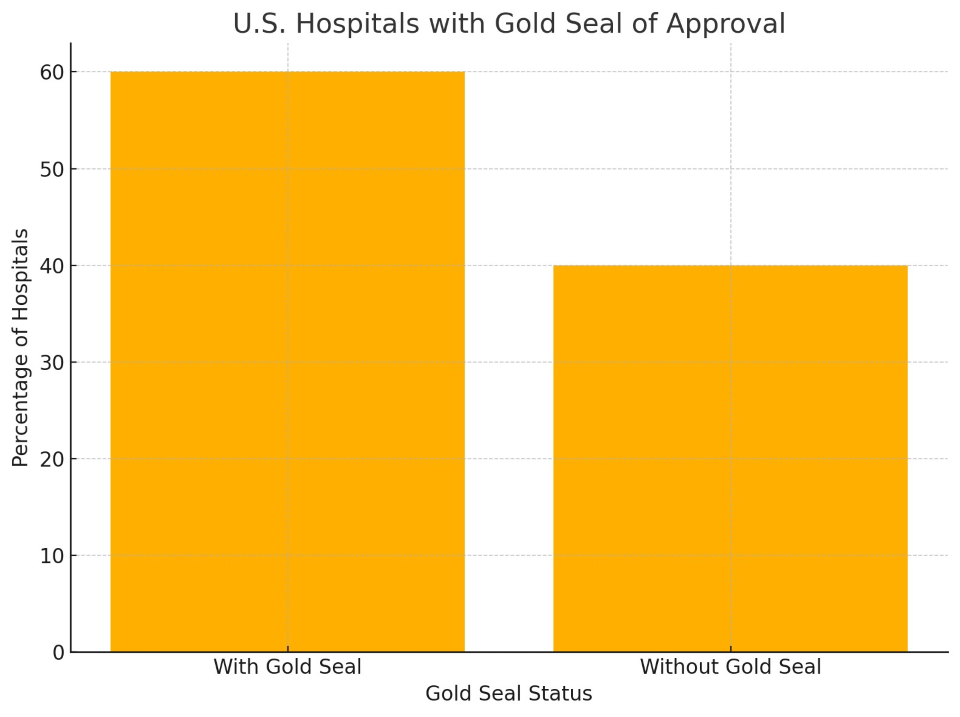A Deep Dive into Quality Assurance in U.S. Healthcare
When it comes to healthcare in the United States, not all hospitals are created equal. Amid debates about cost, access, and outcomes, one clear indicator stands out: The Gold Seal of Approval®. Awarded by The Joint Commission, this symbol serves as a widely recognized benchmark of quality, safety, and accountability. But what does it actually represent—and why should it matter to you?
This article explores what the Gold Seal means, how hospitals earn it, and how it plays a role in shaping healthcare quality across the U.S.
What Is the Gold Seal of Approval?
The Gold Seal of Approval is the official accreditation mark of The Joint Commission, the nation’s leading standards-setting and accrediting body in healthcare. It’s not just a rubber stamp; it’s a sign that a healthcare organization has met rigorous national standards for performance in areas that matter—patient safety, clinical quality, infection control, staff training, and more.
Organizations must undergo comprehensive, on-site evaluations by Joint Commission surveyors, typically once every three years. These evaluations are unannounced and intensive. They include chart reviews, staff interviews, and direct observation of care delivery processes. Only those facilities that meet or exceed the criteria earn the right to display the Gold Seal.
A Quick Look at the Requirements:
-
Compliance with more than 250 individual performance standards
-
Focused review of infection prevention, patient care, and leadership
-
Demonstrated use of data-driven quality improvement practices
Hospitals, behavioral health centers, ambulatory clinics, home care organizations, and even labs can earn accreditation—if they’re willing to do the work.
Why the Gold Seal Matters
For Patients:
When you see the Gold Seal, you know the facility is committed to high standards. This translates to:
For Providers:
It brings structure, discipline, and external validation to internal processes. For leadership, it supports:
Here's a breakdown of some of the primary benefits:
(See the Gold Seal Benefits Table above.)
By the Numbers: Accreditation Across U.S. Hospitals
While the Joint Commission accredits over 22,000 organizations, not every hospital holds the Gold Seal. Based on available data, roughly 60% of U.S. hospitals have earned the Gold Seal of Approval. Here's what that looks like:

60% of U.S. hospitals are accredited by The Joint Commission and allowed to display the Gold Seal.
40% operate without it—often due to cost, resource limitations, or use of alternative accrediting bodies.
That means the seal is both selective and meaningful—hospitals have to work for it.
The Accreditation Process, Step-by-Step
To understand the weight of the Gold Seal, it's important to understand what hospitals go through to get it. Here’s a simplified step-by-step overview:
-
Self-Assessment and Application
The hospital prepares months in advance, reviewing internal policies and ensuring every department is audit-ready.
-
On-Site Survey
A team of expert surveyors arrives—usually unannounced—and conducts a 2-5 day review. This includes:
-
Patient chart audits
-
Staff interviews (doctors, nurses, administrators)
-
Facility tours and compliance checks
-
Emergency preparedness simulations
-
Findings Report
Surveyors identify any gaps. If problems are found, the hospital must create a corrective action plan.
-
Decision and Seal Award
If standards are met, the hospital earns accreditation. If not, they’re placed in a follow-up process until they comply.
-
Ongoing Monitoring
Even after earning the seal, hospitals must regularly submit data and may be subject to follow-up visits.
Real-World Impact: Why It’s More Than a Symbol
Let’s break down the practical outcomes of having (or not having) Gold Seal accreditation:
Alternatives to the Joint Commission
While The Joint Commission is the most well-known accrediting body, others exist:
These agencies are also recognized by the Centers for Medicare and Medicaid Services (CMS), but The Joint Commission’s Gold Seal is generally seen as the gold standard—pun intended.
Criticisms and Limitations
Like any credentialing process, the Gold Seal is not without its critics.
-
Cost: Smaller hospitals, especially in rural areas, may find the process prohibitively expensive.
-
Resource Demands: Preparing for accreditation diverts staff time from day-to-day care.
-
Lack of Public Understanding: Many patients still don’t know what the seal means, reducing its practical influence on patient choice.
Despite these concerns, many health experts argue that the structure and accountability it brings are well worth the trade-offs.
The Gold Seal of Approval isn’t just another healthcare label—it’s a strong indicator of a hospital’s dedication to quality, safety, and constant improvement. In a system often criticized for inconsistency and complexity, it offers a reassuring measure of accountability.
Whether you’re a patient looking for safer care or a health system aiming to prove its quality, the Gold Seal stands as a visible, earned sign that a provider is doing more than the bare minimum—it’s striving to be the best.